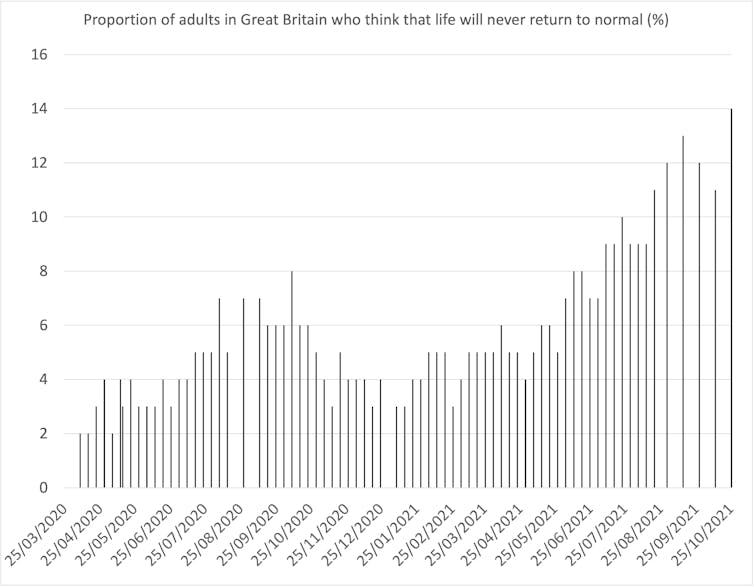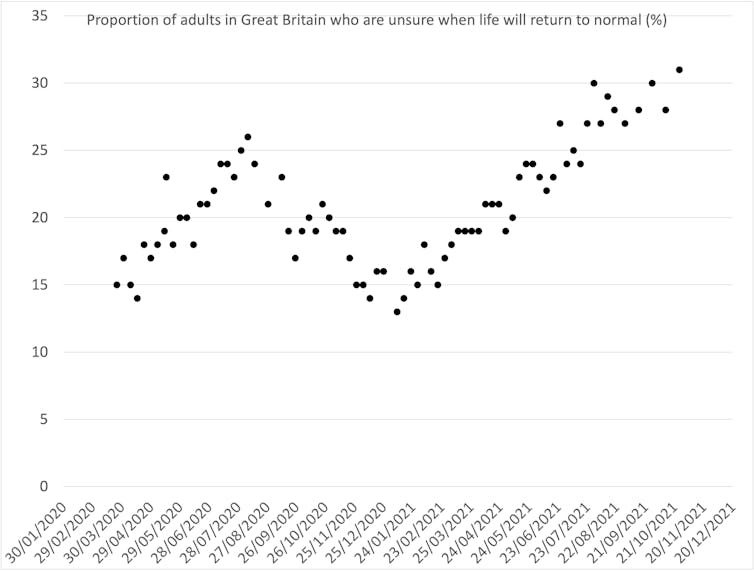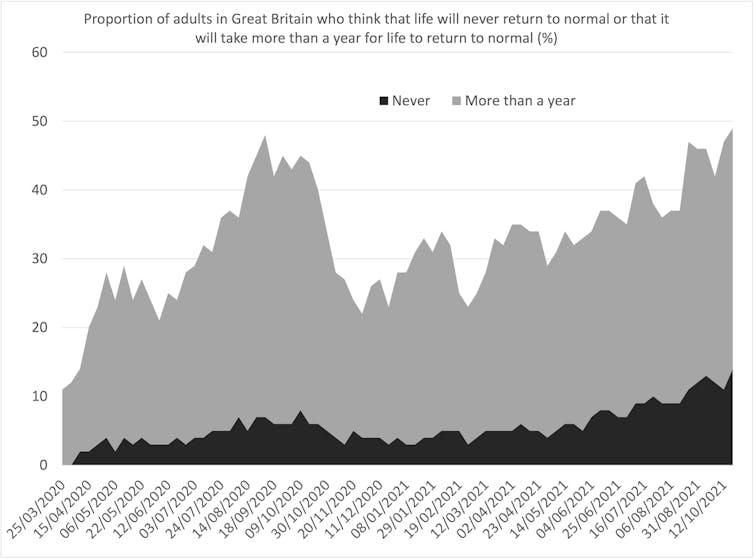What Is It Going to Take for Things to Be Normal Again
No one tin can ever know for certain when life will render to normal later on a particular event, non to the lowest degree because what'due south normal keeps on irresolute, fifty-fifty in normal times. Still, information technology'due south a question we can't assist pondering – specially when new COVID developments, such every bit the emergence of the omicron variant, keep on shifting the pandemic's goalposts.
It's a question that Britain'due south Role for National Statistics (ONS) has been pondering likewise. On March 27 2020, the ONS began request a large sample of the British population when they thought life would return to normal. This was very shortly after the outset wave of the pandemic had begun, with COVID cases and deaths chop-chop ascension. Britain was just days into its outset lockdown.
The ONS surveyed people that twenty-four hour period and for the next ten days. Just 15% at that fourth dimension said they were unsure when life would return to normal, and just xi% of the population thought it might accept a year or more. The remaining 3-quarters thought that life would exist back to normal inside a year of March 2020.
No one dorsum so thought that life might never return to normal. The majority thought normality would return within six months. We humans are (usually) an optimistic bunch.

Over the subsequent xx months, the ONS carried out a farther 76 surveys, unremarkably ane every week. They asked the same question in each survey virtually when people in Groovy Britain idea that life might return to normal.
By the time of the 77th survey, which ended on November 14 2021, the proportion of people who said they were unsure when life would return to normal had doubled to 31%. The proportion who idea it would exist at least a year earlier at that place was a return to normality had tripled to 35%. A further 14% thought that life would never return to normal e'er again. And the proportion who thought that life would return to normal within a year had plunged from 3-quarters to just a fifth. Our religion in a render to normality has complanate.
So far the great ascent in uncertainty has come in two waves. The starting time uncertainty wave peaked in August 2020, when COVID cases and deaths were most zippo. Later that our levels of doubtfulness savage, linearly, to mid-January 2021. At this point, more than of usa thought we knew what might happen side by side than at whatsoever other bespeak across the 77 surveys. Withal, after that we slowly but surely became increasingly more unsure as to what the future might hold. Wave two of being unsure may not yet have peaked.

We define our own normality
At some point, a way of living that nigh of us draw equally normal will arrive – it always does. Just it will be a new normal. The pandemic in our mind has very different twists and turns to the pandemic that is measured by cases, hospitalisations and deaths. Considering information technology exists in our heads also as in the physical globe, the pandemic is partly virtually us – how we each individually feel. The render of normality therefore won't be marked by life returning to what information technology was before 2020, but by us feeling that things are normal once again.
In the about contempo of the 77 surveys, three in v adults said they had "avoided physical contact with others outside their home in the past seven days". 2 in five reported that "but their immediate family unit had been in their home in the past seven days". Neither of these measures had changed from the previous survey. If, for instance, this design of behaviour continues similarly unchanged, it's possible that in time, this will come up feel similar normality.
On the other hand, the question the ONS has now asked 77 dissimilar groups of people (all chosen at random) is not specifically virtually the pandemic – it is nearly "life" in general. It's very probable that at starting time most people replied to the question with the pandemic foremost in their mind. However, as time has passed, other aspects of life will accept shifted too. Things are e'er changing. People's answers may accept come to reflect this, and regardless of the pandemic, may be defining normality as a by that can't be recovered.

Nosotros're now very close to a signal where the majority of adults believe that information technology volition take at least a year (into 2023) for normality to resume – or that it will never render. And of those who don't think this, the majority of them are increasingly unsure about what will happen.
At some point, the majority of us will become used to how things accept changed, and nosotros will begin to run across our changed world as normal. For those of the states who have lived through the pandemic, it will be in our minds forever. Only how nosotros look back and retrieve the pandemic, and the times before March 2020, volition go along on changing.
Source: https://theconversation.com/when-will-life-return-to-normal-after-the-pandemic-172726
0 Response to "What Is It Going to Take for Things to Be Normal Again"
Enregistrer un commentaire